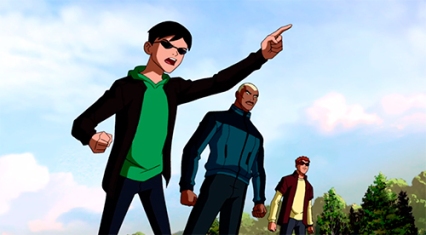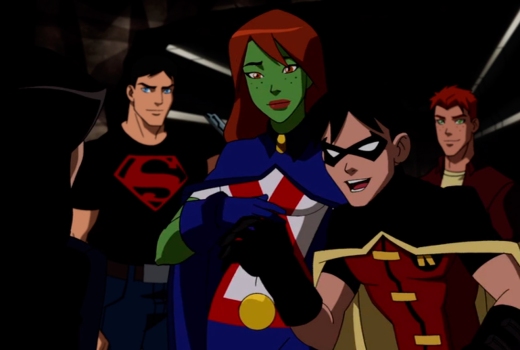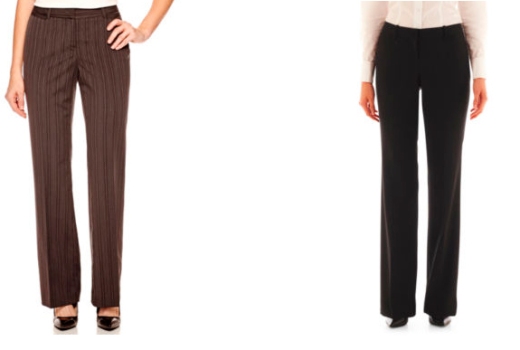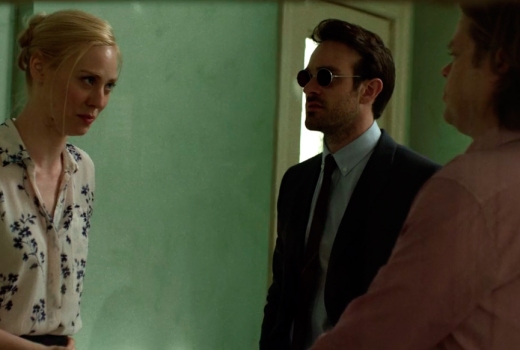DC Comics’ “Young Justice,” a two-year cartoon TV series loosely based on comics, is no “Justice League.”
There, I said it. That’s probably the worst criticism I can level at the show, because despite plot holes you can fly a planet through and characters who pass around both the Idiot Ball and the Angst Ball as if it were nuclear waste, “Young Justice” is pretty good.

Robin, Aqualad and Kid Flash.
The show starts out with a small group of teen boys, who have all served as sidekicks to major superheroes, trying to get into the Justice League (the adult superhero group), only to have the adults tell them they’re too young. The teens, being rebellious, rebel, and after some hijinks, the League ends up making the kids their own team, with their own superhero base and a superhero babysitter.
At first, all the heroes are guys: Aqualad, sidekick to Aquaman; Kid Flash, sidekick to the Flash; Robin, sidekick to Batman. Speedy, the sidekick to the Green Arrow, is holding the Angst Ball at this point in the series, so he runs off to sulk and do some heroing all by himself, because he doesn’t need any meaniehead adults. Early on the team finds and recruits Superboy, who isn’t a sidekick of Superman but instead is his clone.
Later, the team grows to include Miss Martian, whose powers are just like ones her uncle, the Martian Manhunter, has. Miss Martian suffers from an acute case of Smurfette Syndrome for a while before another girl joins the cast–an archer named Artemis.
Aqualad is black and Artemis is at least part Asian, which isn’t necessarily easy to tell at first due to the art style of the show (which, mind you, is pretty good).
 Aqualad is easily the best character on the show, with the best personality and quite possibly the best powers. He’s got gills and can breathe underwater, but he’s also got magic, which he uses to control water, making it into weapons, and he can electrocute people with a touch. And he manages to be interesting despite being a steady, responsible type, so I have to give the writers a lot of credit for writing a strait-laced character well. That’s not always easy–Cyclops of the X-Men can be a real jerk (one time he got married to a girl who looked exactly like his dead girlfriend, had a kid with her, and then when his dead girlfriend came back he dumped the wife and the kid too) and Leonardo, I’m sorry, but you were the most boring Teenage Mutant Ninja Turtle.
Aqualad is easily the best character on the show, with the best personality and quite possibly the best powers. He’s got gills and can breathe underwater, but he’s also got magic, which he uses to control water, making it into weapons, and he can electrocute people with a touch. And he manages to be interesting despite being a steady, responsible type, so I have to give the writers a lot of credit for writing a strait-laced character well. That’s not always easy–Cyclops of the X-Men can be a real jerk (one time he got married to a girl who looked exactly like his dead girlfriend, had a kid with her, and then when his dead girlfriend came back he dumped the wife and the kid too) and Leonardo, I’m sorry, but you were the most boring Teenage Mutant Ninja Turtle.
The other character that really shines here is Lex Luthor, as evil as ever but always a wild card. This Lex Luthor can always be counted on to be on his own side and absolutely nobody else’s. Sometimes that’s good for the kids; sometimes it’s horrible. He usually plays both ends against the middle with great success.
Alas, the show’s writing is uneven, and this manifests most clearly in the characters’ lack of consistency. To some extent I was willing to ignore this because teenagers can be moody, but when you see someone previously portrayed as easy-going suddenly dissolving into a jealous rage it’s pretty hard not to give the writers the stink-eye.
 Then there are the plot holes, which I would have been willing to ignore if they had been based on suspension of disbelief. But they weren’t. They were also related to character inconsistency, in that characters who had previously acted one way in a situation would behave completely differently in a similar situation later, usually because it had to happen that way to make the plot happen.
Then there are the plot holes, which I would have been willing to ignore if they had been based on suspension of disbelief. But they weren’t. They were also related to character inconsistency, in that characters who had previously acted one way in a situation would behave completely differently in a similar situation later, usually because it had to happen that way to make the plot happen.
Because the plot requires it, characters throw around the Idiot Ball and the Angst Ball constantly, and everybody seems to take a turn at being dumb-because-the-plot-demands-it. Even villains and adult superheroes who ought to know better.
It’s still a pretty good show, and I’m sincerely grateful it introduced me to the awesomeness that is Aqualad, but “Justice League” is better. If you have to watch only one, pick “Justice League,” but most likely no one is forcing you to do that, so go ahead, give “Young Justice” a try.
Just make sure you don’t get caught with the Idiot Ball.



 For those of you who are men, prepare to have your minds blown with a graphic description of how women’s clothing actually, really, truly works, and no, you are probably not going to believe this.
For those of you who are men, prepare to have your minds blown with a graphic description of how women’s clothing actually, really, truly works, and no, you are probably not going to believe this. to, and for those of us in the 16-22 range it’s going to be a little tricky and may require bouncing around the store either cheerfully (because we’re smaller than we thought) or gloomily (because we’re bigger).
to, and for those of us in the 16-22 range it’s going to be a little tricky and may require bouncing around the store either cheerfully (because we’re smaller than we thought) or gloomily (because we’re bigger).
 but here are just a few things I loved about Season 2, many of which are a continuation of Season 1:
but here are just a few things I loved about Season 2, many of which are a continuation of Season 1: Gun violence isn’t glamorized. This show is incredibly violent, and while Matt’s fighting style is that of a dancer, the Punisher, and some of the bad guys, use guns. And it’s ugly. It’s bloody, it’s brutal, it’s very uncomfortable to watch. And it should be.
Gun violence isn’t glamorized. This show is incredibly violent, and while Matt’s fighting style is that of a dancer, the Punisher, and some of the bad guys, use guns. And it’s ugly. It’s bloody, it’s brutal, it’s very uncomfortable to watch. And it should be. avoid being a simple sex object. And I’m so glad they didn’t give her that ridiculous loincloth outfit, I mean come on, really?
avoid being a simple sex object. And I’m so glad they didn’t give her that ridiculous loincloth outfit, I mean come on, really? Some movies are good. The best of them become legends, cult favorites or classics, and they have enough fans that people still talk about them decades later: “The Godfather,” “Raiders of the Lost Ark,” “The Princess Bride,” “Casablanca.”
Some movies are good. The best of them become legends, cult favorites or classics, and they have enough fans that people still talk about them decades later: “The Godfather,” “Raiders of the Lost Ark,” “The Princess Bride,” “Casablanca.” Nothing could have matched the original Jurassic Park, but Jurassic World danced so well along the line between charming nostalgia and modern adventure flick that nobody should really care.
Nothing could have matched the original Jurassic Park, but Jurassic World danced so well along the line between charming nostalgia and modern adventure flick that nobody should really care.

